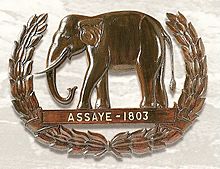Assaye (battle honour) facts for kids
The Assaye battle honour is a special award given to military units. It was created by the Governor General of British India for all the British and Indian army groups that fought in the Battle of Assaye. This important battle happened on September 23, 1803, in western India, near a village called Assaye.
In this battle, a smaller army led by Major General Arthur Wellesley (who later became the famous Duke of Wellington) won against a much larger army of about 50,000 soldiers from the Maratha Confederacy. The British and Indian troops (specifically from the Madras Line) were given the "Assaye" battle honour. They also received a special elephant symbol and an honorary flag to celebrate their bravery. The Madras Battalions proudly remembered this victory for over 100 years until they were disbanded in the 1920s.
Contents
What is a Battle Honour?
A battle honour is like a special badge or award given to a military unit, such as a regiment or battalion. It shows that the unit fought bravely and achieved something important in a specific battle. These honours are often displayed on the unit's flags or uniforms, reminding everyone of their history and courage.
The Battle of Assaye: A Brave Victory
The Battle of Assaye was a key moment in history. It showed how a smaller, well-led force could defeat a much larger enemy. Major General Arthur Wellesley's clever planning and the soldiers' determination led to this amazing victory. This battle was a big step for the British in India.
Units That Received the Assaye Honour
Many different military units were awarded the Assaye battle honour. Some of these units still exist today, while others have changed names or combined with other groups over time.
- The 1st Battalion, the Punjab Regiment of the Pakistan Army is one of the surviving units. It was once known as the 1st/1st Madras Infantry.
- In the Indian Army, only the Madras Sappers still have this unique battle honour.
- The Royal Highland Fusiliers in the British Army are descendants of the 74th (Highland) Regiment of Foot. They are the only British infantry regiment that still carries the Assaye battle honour.
- The Light Dragoons are descendants of the 19th Light Dragoons. They were the only British cavalry regiment in the battle and are the only British cavalry regiment to still have this honour. They even used the Assaye Elephant as their cap badge for a time.
Original Recipients of the Honour
Here are some of the regiments and battalions that were first awarded the Assaye battle honour:
- Madras Pioneers - Today, they are known as the Madras Engineer Group.
- 1st/2nd and 2nd/12th battalions Madras Infantry - Their descendants became the 1st and 10th Battalions, the 1st Punjab Regiment. These units moved to Pakistan when India was divided.
- 5th and 7th Madras Cavalry - These units were disbanded in 1860.
- 1st/10th Madras Infantry (10th MI) - Disbanded in 1890.
- 1st/8th Madras Infantry (8th MI) - Disbanded in 1902.
- 1st/4th Madras Infantry - (2nd Bn Madras Pioneers) - Disbanded in 1933.
- 74th (Highland) Regiment of Foot - This unit combined with the 71st (Highland) Regiment of Foot in 1881 to form the Highland Light Infantry.
- 78th (Highlanders) Regiment of Foot - This unit combined with the 72nd Regiment of Foot in 1881 to form the 2nd Battalion of the Seaforth Highlanders.
- 19th Light Dragoons - This unit was disbanded in 1821.


